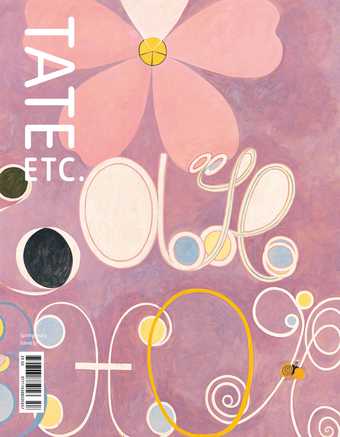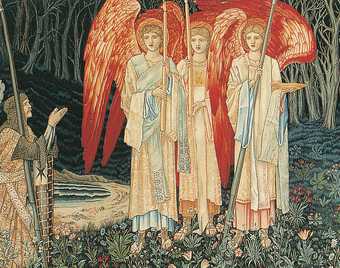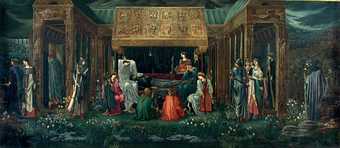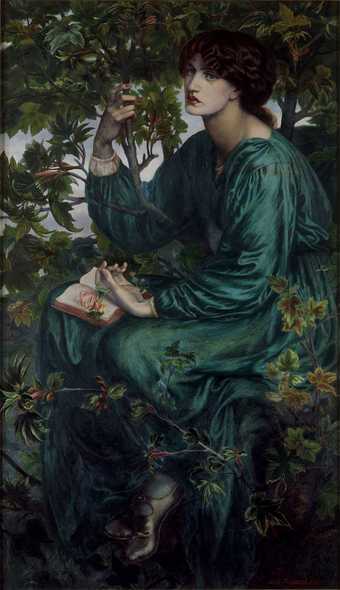
Dante Gabriel Rossetti
The Daydream 1880
Oil paint on canvas
158.7 × 92.7 cm
Photo: Victoria and Albert Museum, London
To think of the Rossettis is to think of Dante Gabriel – the sensuality of his paintings, their potent symbolism, the stories they tell. Yet I don’t think of him as much as I think of his sister Christina, his wife Elizabeth Siddal and the other women who modelled for him, such as Jane Morris, Fanny Cornforth and Alexa Wilding. For it is their faces I see when I look at his paintings and drawings. They linger.
I like Siddal’s paintings – which are mystical, dreamy, almost gentle, even as they carry a jaggedness or angularity within them – as much as I like Dante Gabriel’s. And it’s Christina’s poetry that drives itself into my subconscious, solemn and pious, and in turns ebullient and peculiar. After reading ‘Goblin Market’ (1862) for the first time, I couldn’t free the sound of its verses from my mind; they had come to rest there so strongly. I heard them as an addictive chanting for days, whimsical, melodious and dark:
“Come buy,” call the goblins Hobbling down the glen.
“Oh,” cried Lizzie, “Laura, Laura, You should not peep at goblin men.” Lizzie cover’d up her eyes,
Cover’d close lest they should look; Laura rear’d her glossy head,
And whisper’d like the restless brook: “Look, Lizzie, look, Lizzie,
Down the glen tramp little men.”
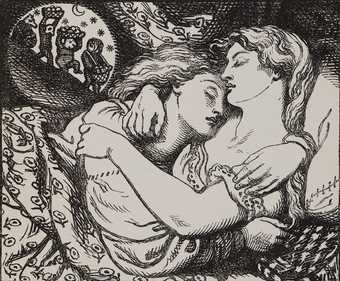
Title page to Goblin Market and Other Poems 1862 by Christina Rossetti (detail), wood engraving by WJ Linton after Dante Gabriel Rossetti
Photo: Victoria and Albert Museum, London
As character models for paintings by Dante Gabriel and the other Pre-Raphaelite artists, such as John Everett Millais, William Holman Hunt and Edward Burne-Jones, Christina and Siddal lived fully and richly within a space of creative expression, ‘performing’ scenes from literature or the Bible (notably, Christina as the Virgin Mary, Siddal as Viola from Twelfth Night and, most famously, as Ophelia), while also moving between painting and writing. I wonder if the different positions that they occupied – model, painter, writer – were ever brought to meet? Did one affect the other? It seems possible that the experiences they had while art modelling might have been generative. But perhaps my imagination is getting the better of me. Maybe the limits of gender, of existing as a woman – even within a revolutionary, artistic community such as the Pre-Raphaelites – were still strongly, forbiddingly, in place. It was a brotherhood, after all, even if women were, informally at least, a part of it. I’ve thought that, since Dante Gabriel used the same model for many months or even years, his relationship with her might have been transformed, made deeper, unlike if he’d used a new model for each drawing or painting. To share this kind of experience with another is intimate; over an extended period, more intimate still. A relationship built from the blurring of art and life.
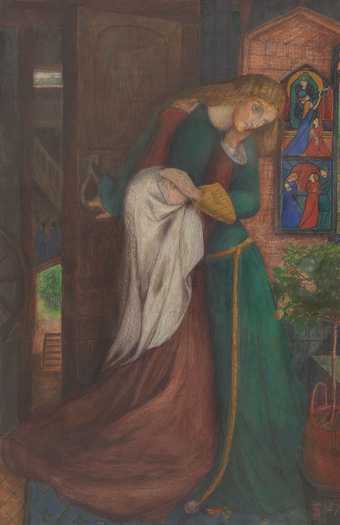
Elizabeth Siddal
Lady Clare c.1854–7
Watercolour on paper
33.8 × 25.4 cm
Private Collection
In her short poem ‘In an Artist’s Studio’ (1856), Christina describes the artist as one who ‘feeds’ upon the model’s face ‘by day and night’ – she who appears on canvas ‘Not as she is, but as she fills his dream.’ In this characterisation, the artist consumes the model, consumes her beauty, her true nature invisible to him. Christina can be knifelike in her writing, as evidenced in her poem ‘No, Thank You, John’ (1862), conjectured to have been written about the painter John Brett, whose hand in marriage she supposedly rejected. I wonder what Dante Gabriel and the Pre-Raphaelites thought of ‘In an Artist’s Studio’, if they ever read it, that is. It was bold of Christina to write it, but it was not published during her lifetime.

Dante Gabriel Rossetti
Study for Delia in ‘The Return of Tibullus to Delia’ 1860–2
Graphite on paper, mounted on card
22.2 × 19.6 cm
Photo © The Fitzwilliam Museum
Maybe the other women of that circle felt differently. Perhaps Siddal did. She married Dante Gabriel, as tumultuous as that marriage was, marked by his numerous affairs that continued until her death: an overdose of laudanum at the age of 32. And she painted him, artist and model reversed. I wish I could go back through time and listen to a conversation between Christina, Siddal, Morris, Cornforth, Wilding, Georgiana Burne-Jones, Annie Miller. Were they friends? Did they commiserate or were they competitive with each other? Could the space between them have been generative too?
To contemplate Elizabeth Siddal is to be torn between looking at the drawings and paintings in which she appeared and those she herself made. Her face is subtly expressive, angelic, melancholy. In portraits, her gaze is downcast. She doesn’t look back at the one who is looking at her, at the artist or the viewer. Yet in her self-portrait from 1853–4 she looks up, her gaze directed outward. Did Dante Gabriel ask her to look down when he painted or drew her? After all, it is traditionally the artist who directs the pose, the gestures of the model. Or was it her decision?
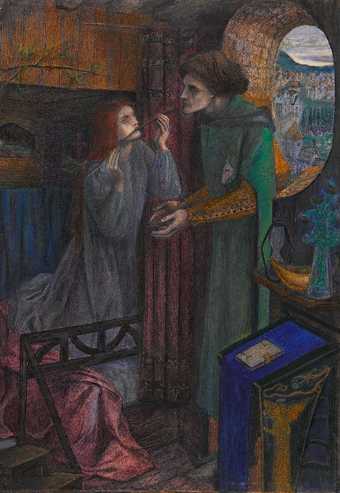
Elizabeth Siddal
Clerk Saunders 1857
Watercolour, bodycolour and coloured chalks on paper, laid on a stretcher
28.4 x 18.1 cm
Photo © The Fitzwilliam Museum
Her own drawings and paintings are often far stranger and more haunting than the ones she sat for. In Clerk Saunders 1857, based on the ballad of the same name, we see a woman kissing a willow wand while the ghost of her dead lover, murdered by her brother, holds out his arms to her. The two figures are close, but they aren’t touching, her face as white and ghostly as his. It’s a dark but oddly colourful painting, large patches of brightness emerging from the shadows. In the oval window behind them is a city, bathed in what looks to be morning light. A medieval prayer book appears in the painting too, placed on a bright blue, draped table or lectern. Now we are seeing through Siddal’s eyes, through that gaze that has been withheld from us.

Dante Gabriel Rossetti
Bocca Baciata (The Mouth that Has Been Kissed) 1859
Oil paint on panel
32.1 × 27 cm
Photo © Museum of Fine Art, Boston
We know that Dante Gabriel was interested in performance. When they were children, he and Christina, along with their siblings William Michael and Maria Francesca, regularly put on plays at home, for which Dante Gabriel designed the sets and costumes. His work sometimes feels like an extension of that, as grounded in scene as it is in painting. In Ecce Ancilla Domini! 1849–50, for which Christina modelled, Mary is drawing back against the wall or is perhaps rising from sleep, startled by the archangel Gabriel, as if she’s been cornered. He’s come to tell her of her fate, holding a large stalk of white lilies, a look of stern calmness on his face, a white dove at his shoulder. The room is painted in shades of white, which contrast with Mary’s red hair and the blue sky filling the window, symbolic of purity, the blood of Christ, and Heaven.
I like to imagine that Dante Gabriel saw the space of a scene as being as compelling as that of a painting. Could he have been as interested in the energy of the performance as he was in the painting that resulted from it? Though he painted his sister for Ecce Ancilla Domini!, he was clearly interested in the relationship between artist and model. From Siddal to Morris to Cornforth to Wilding, he had his muses. There were many women he found beautiful, whom he wanted to paint.
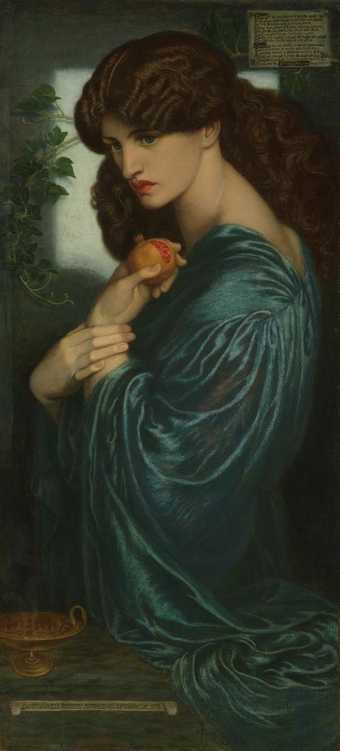
Dante Gabriel Rossetti
Proserpine (1874)
Tate
In Christina’s poetry, we see the influence of the theatrical too, not only in ‘Goblin Market’, but in ‘The Months: A Pageant’ (1881), a kind of play in verse in which the ‘characters’ featured – or, as Christina calls them, ‘personifications’ – are January through December, along with local birds and animals. The opening scene: ‘[A room in a large comfortable cottage; a fire burning on the hearth; a table on which the breakfast things have been left standing. January discovered seated by the fire.]’ Both ‘The Months: A Pageant’ and ‘Goblin Market’ are playful and childlike, as is Sing-Song: A Nursery Rhyme Book (1872). It’s enjoyable to see this crossing of theatre with poetry and painting, the crossing of the private and the public, and of what is put on in the home or the studio with what becomes publicly seen or read. The viewer or the reader encounters the final form, the poem, or the painting, but what do the artist and the model, the playwright and the costume and set designer, and the actress and actor encounter in one another?
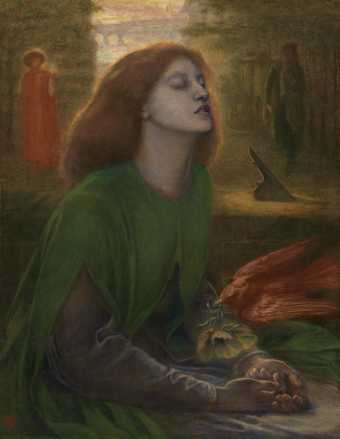
Dante Gabriel Rossetti
Beata Beatrix (c.1864–70)
Tate
The Pre-Raphaelites obviously inspired each other a great deal, even as they were inspired by their models and their models inspired by them. Jane Morris, alongside her husband William Morris, created tapestries, furniture and murals, which led to the Arts and Crafts movement. Dante Gabriel was a part of that too. And, while she was alive, Siddal. It was a time and place brimming with collaborations of all kinds, and experimentation, not just artistically but in the very ways that the Pre-Raphaelites lived and knew each other. Many of the models who posed for the artists, including Morris and Annie Miller, came from working class or poor families. Modelling lifted them out of poverty. This is another notable crossing at a time when those of different economic classes didn’t often mix.
And now we see them, in 2023, the artists’ models gazing back at us, or toward a horizon we can only imagine, or at the scene in which they are playing a part. Sometimes I think I can catch a glimpse of their inner worlds in their eyes, their interiority. A glimpse that, in the very wealth of his paintings, Dante Gabriel Rossetti managed to capture.
Amina Cain is a writer living in Los Angeles. Her latest books are A Horse at Night: On Writing and Indelicacy, both published by Daunt Books.
The Rossettis, Tate Britain, 6 April – 24 September. Curated by Carol Jacobi, Curator, British Art 1850–1915, Tate Britain and James Finch, Assistant Curator, 19th Century British Art, Tate Britain. Supported by The Rossettis Exhibition Supporters Circle and Tate Members.

